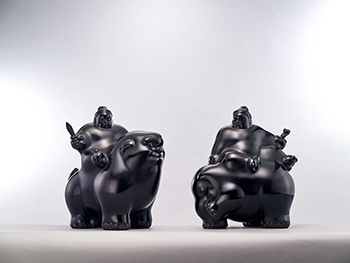ILLUSTRATED
Li Chen Sculpture 1992-2002, Asia Art Center, Taipei, 2004, color illustrated, pp. 80-81Li Chen in 52nd Venice Biennale - Energy of Emptiness, Asia Art Center, Taipei, 2007, colorillustrated, pp. 110-115; black-and-white illustrated, pp. 218-219 (similar version)Li Chen in Beijing - In Search of Spiritual Space, Asia Art Center, Taipei, 2008, color illustrated, pp.40-49; black-and-white illustrated, pp. 196-197 (similar version)This sculpture is to be sold with a certificate of authenticity issued by Asia Art Center.
Catalogue Note:
When examining the artistic career of contemporary sculptor Li Chen, one can see that, in his early “Beauty of Emptiness” series, while seeking to portray different aspects of the Buddha, Li also incorporated some of his own aesthetic attitudes, so that besides the religious power of the work, creating it also provided the artist himself with an opportunity to practice Buddhist self-cultivation in his own life, and the finished work opened up new artistic possibilities for contemporary Buddhist statuary. 1998 saw the beginnings of a shift in Li’s style; starting with his “Energy of Emptiness” series, one begins to see the soft, curving lines that have become so characteristic of Li’s work, and from this period onwards his statutes have a distinctive roundness and fullness about them. Although Li Chen’s creative work continued to be influenced by Zen thought and other aspects of Buddhist philosophy, in his later work one no longer sees figures holding Buddhist regalia or making conventional Buddhist hand movements; rather, they are shown in various kinds of “worldly” poses, laughing and happy. Besides the inherent quality of the sculpting, these later pieces also embody a finely expressed emotional sensibility that warms the heart of the viewer.
In Han Buddhism thought, two of the Three Holy Ones of the Huayan (Flower Garland) School of Buddhism are Manjusri and Samantabhadra. Holding a treasured sword, Manjusri cuts down all the troubles of the secular world in a carefree manner, representing the disconnecting of all foolishness. This serves as symbol of supreme wisdom. Riding on an auspicious lion that scares away corruption with its roar represents an infinite wisdom, and explains how wisdom is the fundamental way. Samantabhadra, also known as Great Conduct Bodhisattva, willingly practices dharma with sentient beings. Holding a lotus in the palm of his hand symbolizes fulfillment and perfection. Riding on an elephant represents fortitude, a lack of regret, and a boundless fearlessness. Li Chen was able to simplify the dharma-character and minimize the face and lines of the sculpture. Integrating Buddhist philosophy into contemporary shapes and infused with an internal spiritual energy, Removing Dharmacharacter and Removing Deification are two harmonious sculpture works in which Li Chen incorporates the artistic imagery of western minimalism. The dark body and delicate texture of the surface reveal a strong contemporary sense in these works, eliminating existing religious barriers and expressing a unique form belonging to an Eastern theme of sculpture.
